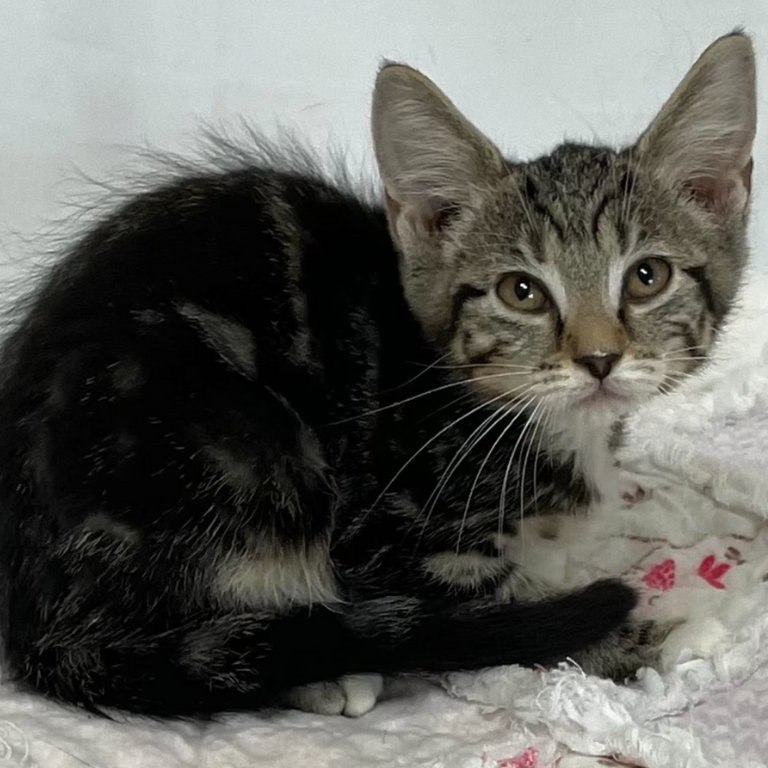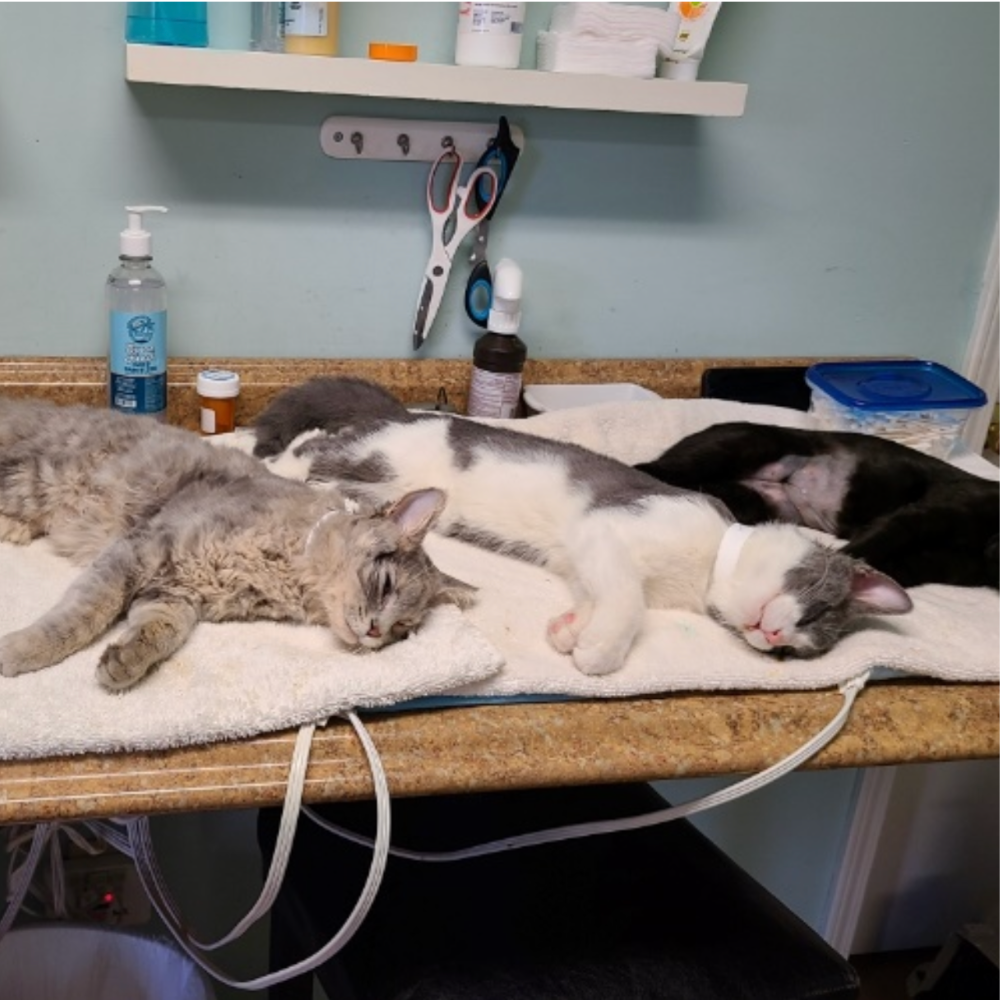Trap, Neuter, Vaccinate, and Return
By 2009, the Grant County Animal Shelter, working with the GCFOS, had moved from a 96% euthanasia rate to one that paralleled the other northern Kentucky counties. That meant only about 59% of the kittens and cats who entered the shelter left the shelter alive. On paper, that equaled success. But those numbers meant one out of every two shelter cats had to be destroyed. Said another way, it meant choosing which one of these two hopeful, trusting, innocent, blameless kittens, below, deserved to die:
The people who knew these felines knew that none should die. Yet, many county residents were upset by too many free-roaming cats in their neighborhoods. Eventually, someone in those neighborhoods starts carrying the cats to the shelter. In 2009, that meant that 828 entered the Grant County Animal Shelter and only 496 were adopted. The harsh fact was that there were not enough people to adopt all the homeless cats.
The Solution
The people who cared at the Shelter and in the GCFOS realized that their only hope was to reduce the number of cats entering the shelter. Finally, the GCFOS found hope for these cats. In 2009, the GCFOS competed for one of 15 grants to be awarded nationwide by PetSmart Charities to start a Trap-Neuter-Vaccinate-Return (TNVR) Project. The group won one of those pilot grants for Grant County. Since then, the GCFOS has been spaying and neutering about 400 – 600 free-roaming Grant County cats per year. During that time, the group has worked out an arrangement with the Grant County Animal Shelter that has saved, quite literally, thousands of feline lives.
This TNVR program. like everything else that the GCFOS does, is a joint venture with the Shelter. Typically, whenever someone phones the Shelter about or even actually arrives at there carrying captured free-roaming cats, the shelter staff talks about the Friends of the Shelter’s TNVR program. And those staff members talk passionately. Nearly every person who intended to leave those cats at the shelter at least talks to a member of the Friend’s TNVR team. Most of the time those people are persuaded to select TNVR for those cats rather than death.
The Way the Campaign Works
Free-roaming cats are trapped by GCFOS volunteers. Then transported to a spay/neuter clinic where they are neutered or spayed and vaccinated. Then the cats are returned to the location where someone agreed to feed and shelter them. This system keeps both cat haters and cat lovers reasonably content.
For the cat haters, the answers are:
I hate the yowling, the stench!
If cats are neutered, they won’t “mark” a yard or fight over mates. And if females aren’t in heat, they won’t attract males, so fewer cats.
I just hate cats, don’t want them around at all!
Cats are excellent breeders. They’ll never disappear completely. If animal control traps and removes or kills them, that just creates a vacuum effect. New cats move in and start the cycle all over. Cats who’ve been through TNVR won’t make new cats and prevent visitors from moving in.
I still want cats gone!
Be realistic. Poisoning is a crime; one just made more serious by the Kentucky legislature. And, if they died, new, unfixed cats would move in. That’s why animal control doesn’t waste taxpayer money trying to eliminate cats.
For the cat lovers, the answers are:
I feel so bad for free-roaming cats. I feed them, but I wish I could do more.
Free-roaming cats can have good quality lives. But there IS more to do. Help them be spayed or neutered. Having kittens is hard on a cat’s health and kittens born outside get sick, suffer, and die. Spaying/neutering stops that.
Trapping seems like a scary process. I hate to put them through it.
Compared to all that free-roaming cats go through if they are NOT fixed, the stress of trapping and transport is much less. Fixed females won’t go into heat and attract unwelcome males, won’t have kittens, and are at less risk for rabies and mammary cancer. Fixed males don’t get hurt fighting over females, don’t anger people with spraying to mark territory, and don’t get sick from horrible diseases spread by fighting.
I want to do more.
Contact the GCFOS about creating shelters for free-roaming cats. Cold and rain are hard to handle. A cat lover can help.
The Need for Participation
To make this TNVR program work, requires help from people who care about animals. It takes people’s time and donated dollars. Of course, the people already involved have discovered that the satisfaction makes it worthwhile. One volunteer said it perfectly. During a recent trapping, one man, who had a colony of cats roaming his neighborhood, asked a trapping volunteer, “How much do you get paid for doing this?” She responded, “No one could ever pay me enough to do this, but I’ll do it for free, for the cats.”
Every aspect of the TNVR campaign has been done with donations from volunteers – donated dollars to purchase traps, donated time, donated gas, donated vehicles, and donated dollars for surgeries and vaccinations. So, donations are essential. They are an investment in, literally, enabling cats to live.




























 Dramatic cases of animal injury and recovery are common at the Grant County Friends of the Animal Shelter and Castle is no exception. We encourage you to read Castle’s story and learn more about how you can help this resilient cat’s recovery efforts.
Dramatic cases of animal injury and recovery are common at the Grant County Friends of the Animal Shelter and Castle is no exception. We encourage you to read Castle’s story and learn more about how you can help this resilient cat’s recovery efforts. When a law enforcement officer asks for help from the shelter staff, it can be very serious. Situations don’t get much more serious than Marley’s was. Read Marley’s story and learn more about how you can help this sweet dog’s recovery efforts.
When a law enforcement officer asks for help from the shelter staff, it can be very serious. Situations don’t get much more serious than Marley’s was. Read Marley’s story and learn more about how you can help this sweet dog’s recovery efforts.